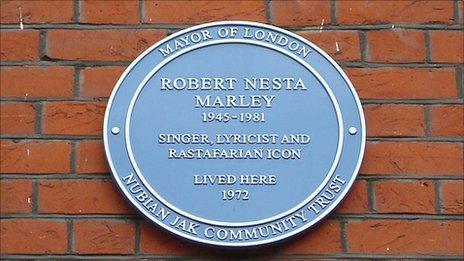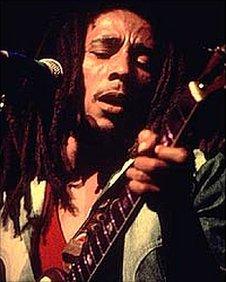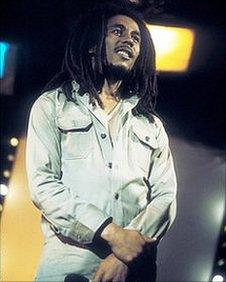Bob Marley's London life on 30th anniversary of death
- Published

A blue plaque marks the spot but Ridgmount Gardens in Camden is one of several London homes associated with Bob Marley
The London footprint left by reggae legend Bob Marley, who died exactly 30 years ago, includes a Bayswater B&B, a Chelsea townhouse and the unlikely setting of a school gym in Peckham.
Guide books tend to point visitors to an apartment block in Camden, where a heritage plaque unveiled in 2006 honours the Jamaican musician at his former north London home.
Robert Nesta Marley lived at 34 Ridgmount Gardens in 1972 when he first came to England, just as his group the Wailers were making a name for themselves.
But this tells only part of the story.
The reggae artist is associated with at least three other addresses in the capital, living and working in them aside from the many places he visited, played or hung out in.
Some are long-gone music venues such as the Greyhound in Fulham Palace Road and the Rainbow in Finsbury Park.
As a keen footballer he also enjoyed kickabouts in Battersea Park and at a sports centre in Fulham.
Marley regarded London as his "second base and spiritual home", according to music historian Russell Clarke.
He calculates that 30% of his time in his first 10 years of recording were spent there, putting down roots in the burgeoning communities of Harlesden and west London focused on the Caribbean.
12a Queensborough Terrace W2
Contrary to the official version, Marley's story started in fact in early 1971, at this Bayswater B&B-style hotel.

Marley has been a cultural icon since his premature death
The former welder and semi-pro musician had come under the patronage of singer Johnny Nash, who had an affinity for reggae and pop and who brought him over to England via Sweden after signing a publishing deal.
Accompanied by Neville 'Bunny' Livingstone and Peter Tosh, the fledgling Wailers shared one room here without a kitchen for three months - at considerable cost to their lifestyle.
"They were all followers of Rastafari at this point and unable to cook for themselves the sort of food their religion would allow," says Russell Clarke.
"They existed on fish and chips and Indian vegetarian food inbetween rehearsing and writing songs."
The group complained so much that their management eventually moved them out.
The Circle, Neasden NW2
Next stop, the somewhat bizarre confines of a semi-detached house in Neasden.
From here Marley & Co would have enjoyed panoramic views of the North Circular, parts of Wembley and the Welsh Harp by Brent Reservoir.
But the group were becoming more and more dissatisfied.
Signed now to CBS as a favour to Johnny Nash, they had earlier cut a record at the label's Whitfield Street studios in central London.
All sorts of things were promised for the track, Reggae on Broadway, but nothing materialised in terms of promotion.
To compound matters, the Wailers' passports were being held by Nash's management, while Marley himself was committed to a tour with the singer as his accompanist.
"The tour was essentially the two of them on acoustic guitars, and by all accounts they played hundreds of shows - in schools around the country," says Russell Clarke.
Peckham Manor School, Cator Street SE15
This was one such venue, and photographs have recently come to light in a south London blog, external showing Marley - with short Afro hair topped off with a striped beanie - and Nash in situ here in 1972.
Former art teacher Keith Baugh had met the pair in a Soho club. "They were bemoaning the fact they couldn't get their single in the top 40," he recalls.
"I suggested as a bit of a promotion they should come down and play to the kids at our school, and a few days later they came down and played two 45-minute sets."
The show took place in the school's gym in Cator Street - now part of the Damilola Taylor Youth Centre in Peckham, the school having long closed down.
The set-list included Reggae on Broadway and Nash's hit single I Can See Clearly Now.
There was also a Marley song, Stir it Up, which would soon come to the attention of Island Records boss Chris Blackwell, usher in the Ridgmount Gardens period and change the fortunes of the Wailers for good.
Lyceum Ballroom, Wellington Street WC1
Marley's international breakthrough was fashioned at this one-time music venue, home now to the long running production The Lion King.
Over two nights in July 1975, the Wailers played in front of a packed crowd - the concerts having sold out in a mere two hours.
DJ and filmmaker Don Letts describes the event in his memoirs as "the closest thing I've ever had to a religious experience".
Chris Blackwell was present on the first night and noticed that when the group went into the song No Woman, No Cry, it was greeted ecstatically by the audience.
He arranged for the second show to be recorded, hanging microphones from the roof to capture the reaction and the singing along.
According to Russell Clarke, "There's something about that album. It was the one that crossed over and introduced Bob's music to me as a pasty-faced white teenager at that point."
42 Oakley Street, Chelsea SW3
1977 brought another sojourn in London for Marley, this time for nearly two years as he and the Wailers decamped to this swish Chelsea townhouse.
The financial constraints of the past were gone; the reggae star could afford a cook and was able to bankroll a huge entourage.

A feature-length film will mark the 30th anniversary of the music icon's death
"It was a big gang house where everybody would hang out," says Russell Clarke, "not just the group's entourage but all sorts of people from various communities in London."
Marley had a cosy retreat at the top of the house where he was visited by his girlfriend Cindy Breakspeare, a former Miss World.
It was also a highly creative time and the Wailers went on to make a further two albums, Exodus and Kaya, the latter recorded in a converted laundry in Ravenscourt Park.
This was the era of hits such as Jammin', One Love and Waiting in Vain.
It was also at this point, notes Clarke, that a cancerous tumour was discovered in Marley's toe, which later would spread fatally to the rest of his body.
Within three years reggae's global ambassador would be dead, leaving a wife, 13 children and no will - and a back catalogue of music that would be mined, reversioned and reissued for decades to come.
- Published15 March 2011
- Published8 April 2011